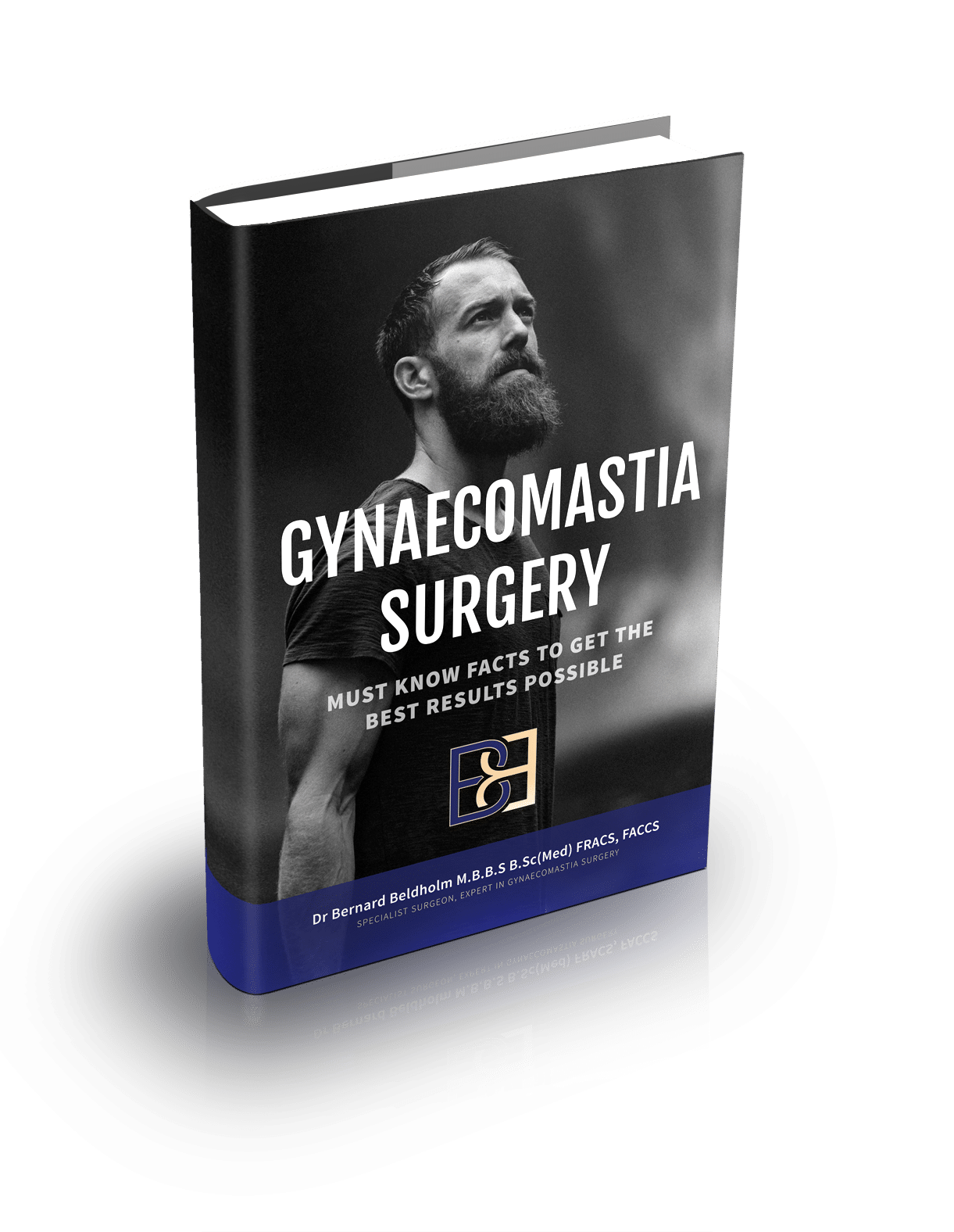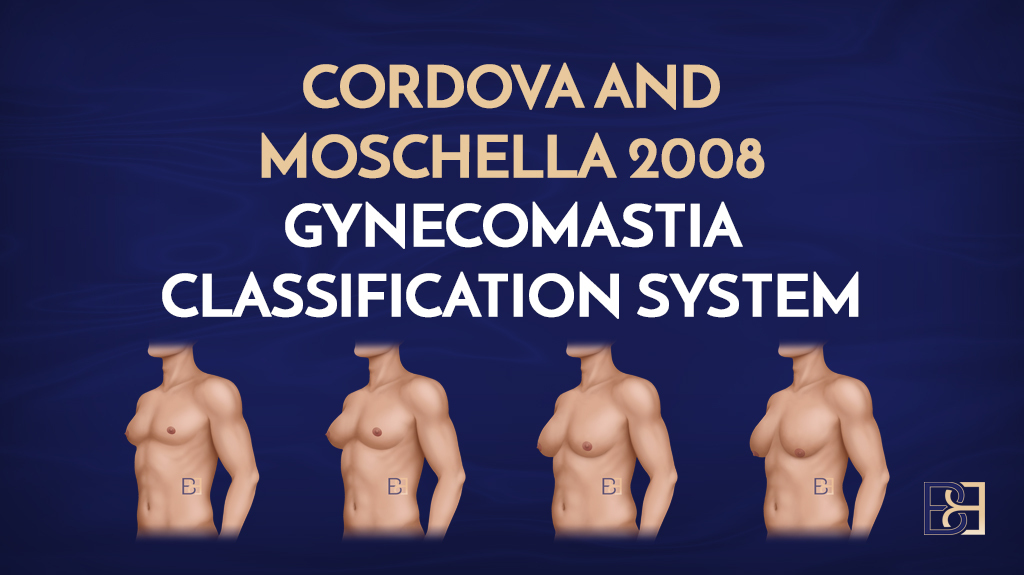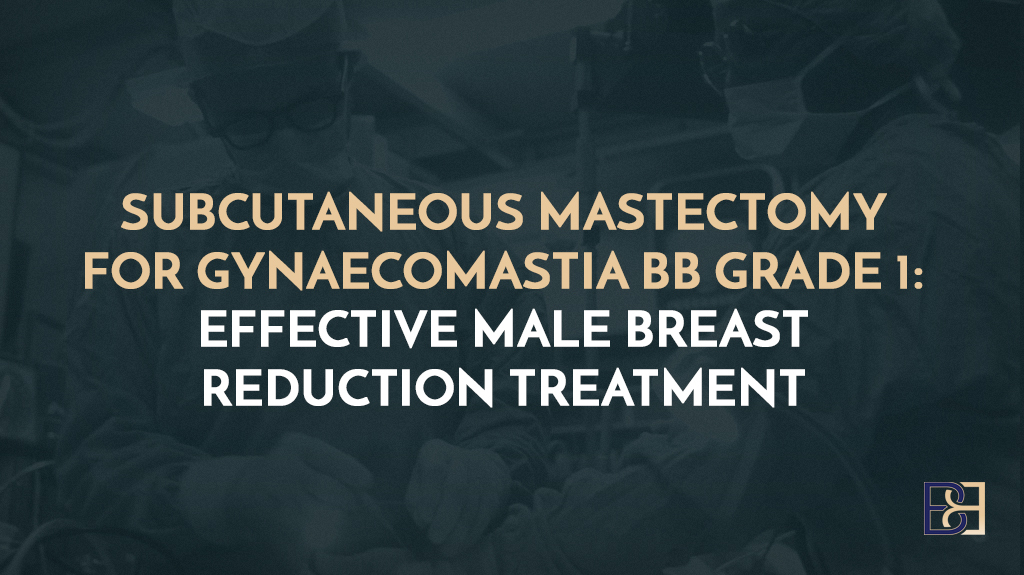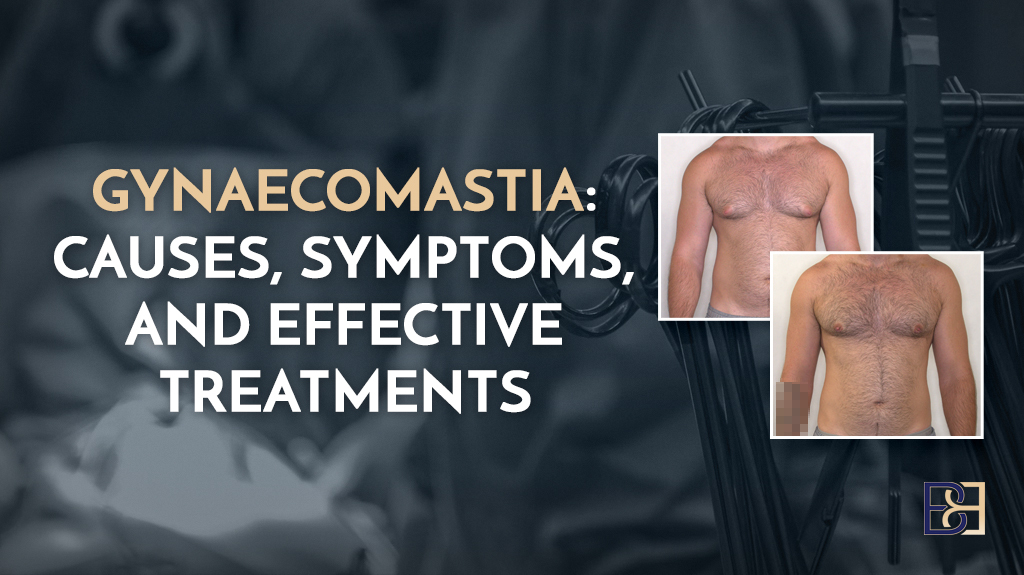Performing a subcutaneous mastectomy is usually part of most gynaecomastia surgery procedures. This article will discuss treatment for grade 1 gynaecomastia with subcutaneous mastectomy without liposuction.
Beldholm 2024 gynaecomastia grading system Grade 1 refers to:
- Small Gynaecomastia that is confined to within the areola
- Includes “puffy nipple” or protruding NAC
- Very common in clients who do bodybuilding and have used anabolic steroids
- The treatment recommendation for this grade is a subcutaneous mastectomy with infra-areolar incision. No liposuction is required.
Check out my other article on treating gynaecomastia with subcutaneous mastectomy, including VASER liposuction (Suction-assisted lipectomy).
Subcutaneous mastectomy for gynaecomastia is a surgical procedure designed to effectively reduce excess male breast tissue. This surgery removes glandular tissue while preserving the nipple-areola complex, achieving both aesthetic and functional outcomes. Patients often turn to subcutaneous mastectomy for gynaecomastia when other methods fail to deliver results. This article will explore the procedure, its benefits, and what you can expect if considering this treatment option.

Tattoo ( on Rught forearm) blurred for privacy
Disclaimer: Operation performed by Dr Bernard Beldholm. Adult content, surgery has risks; individual results vary, seek 2nd opinion. Please see the full disclaimer.
Book your appointment online now
Key Takeaways
- Subcutaneous mastectomy effectively treats gynaecomastia by removing glandular breast tissue while preserving the nipple-areola complex, minimising scarring.
- This surgical option is especially beneficial for severe cases of gynaecomastia.
- Understanding the causes, symptoms, and surgical techniques associated with gynaecomastia is crucial for effective treatment planning and achieving optimal surgical outcomes.
Subcutaneous Mastectomy for Gynaecomastia: Effective Male Breast Reduction Treatment
Subcutaneous mastectomy is a specialised surgical treatment designed to treat the enlargement of male breast tissue, a condition known as gynaecomastia. Unlike other methods, subcutaneous mastectomy focuses on removing glandular breast tissue while preserving the nipple-areola complex, ensuring both effective results and aesthetic appeal.

The surgery involves meticulous techniques to excise the excess glandular tissue responsible for the abnormal breast enlargement. Targeting the root cause of the condition, subcutaneous mastectomy offers a solution for persistent gynaecomastia. Patients who have undergone this procedure often report significant success in the changes in their physical appearance, highlighting its effectiveness as a male breast reduction treatment.
Indications for Male Subcutaneous Mastectomy

Subcutaneous mastectomy with no liposuction is specifically indicated for patients presenting with gynaecomastia that is localised within the areola, often referred to as “puffy nipple.” This condition is prevalent among bodybuilders who have a history of using anabolic steroids. The procedure is suitable for cases where there is a distinct glandular enlargement without significant fat accumulation. By focusing on the glandular tissue, this approach aims to achieve a flatter and more contoured chest appearance while minimising scarring through an infra-areolar incision.
Understanding Gynaecomastia

Gynaecomastia involves the abnormal enlargement of male breast tissue, often resulting in a feminine appearance that can be distressing for those affected. This condition is prevalent among males, with incidence rates ranging from 32% to 40%, and is particularly common in teenagers and the elderly. The distinction between true gynaecomastia, caused by the overgrowth of glandular breast tissue, and pseudo-gynaecomastia, primarily due to excess fat, is crucial for understanding and managing the condition effectively.
The presence of gynaecomastia often leads to physical discomfort, creating a need for effective treatment options. Surgical interventions like subcutaneous mastectomy are often considered when the condition is persistent and significantly impacts the individual’s quality of life.
Understanding the causes, symptoms, and diagnosis of gynaecomastia is essential for those considering treatment. Exploring these aspects helps us better understand the need for surgical solutions and the relief they offer.
Causes of Gynaecomastia
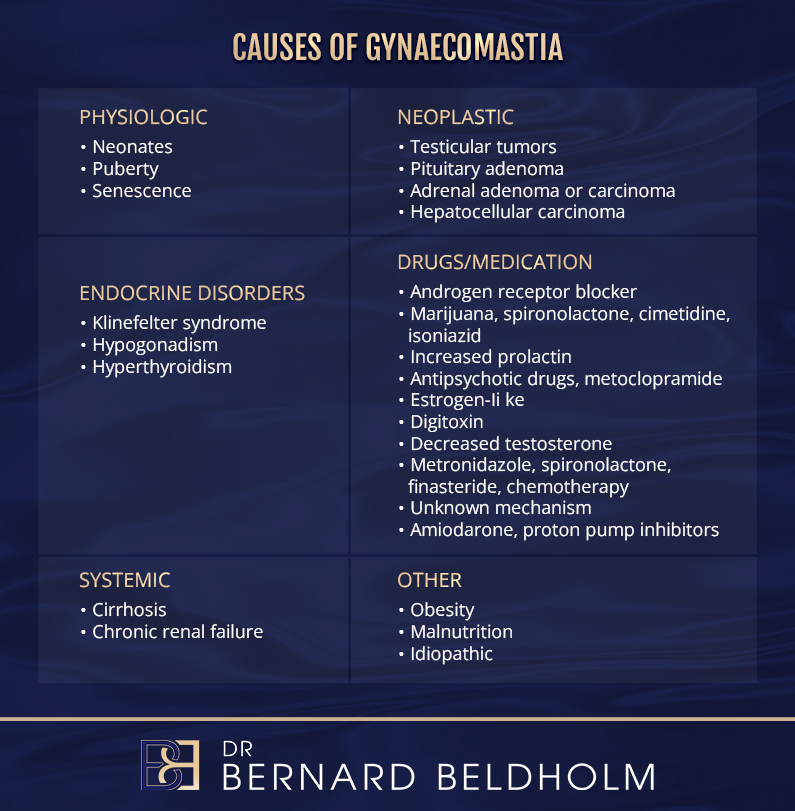
Gynaecomastia is primarily caused by hormonal imbalances, particularly an increase in oestrogen or a decrease in testosterone levels, including cases of bilateral gynaecomastia.
These hormonal changes can occur naturally, especially during puberty or aging, but they can also be induced by certain medications and substances. For instance, medications for:
ulcers
anxiety
prostate cancer treatments
anabolic steroids
marijuana
are known contributors to the development of gynaecomastia.
Additionally, underlying health conditions such as liver disease, kidney disease, and tumours can lead to hormonal imbalances that result in gynaecomastia. In some cases, the condition arises idiopathically, meaning its cause remains unknown despite thorough investigation. Understanding these diverse causes is crucial for effective gynaecomastia management and treatment planning.
Symptoms and Diagnosis

Diagnosing gynaecomastia typically involves a thorough physical examination and a review of the patient’s medical history. Common symptoms include swollen breast tissue, tenderness in the breast area, and sometimes lumps or increased fatty tissue beneath the nipple. These clinical characteristics help differentiate gynaecomastia from other conditions, such as male breast cancer, which requires different treatment approaches.
During the physical examination, healthcare providers check for breast tissue enlargement and tenderness, which are key indicators of gynaecomastia. This thorough diagnostic process ensures that the appropriate treatment plan is developed and tailored to the individual’s specific condition and needs.
What is Subcutaneous Mastectomy?

Subcutaneous mastectomy is a surgical procedure specifically designed to reduce excess glandular breast tissue in males. This procedure involves the careful removal of glandular tissue while preserving the nipple-areola complex, which is essential for maintaining the integrity of the chest. By targeting the underlying glandular tissue, subcutaneous mastectomy provides an effective solution for those suffering from persistent gynaecomastia.
The Procedure: Step-by-Step
The subcutaneous mastectomy procedure involves several key steps, from preoperative preparation to postoperative care. By understanding each phase of the surgery, patients can better prepare for the procedure and ensure optimal recovery.
Let’s explore these steps in detail, beginning with the essential preoperative preparations.
Preoperative Preparation
Before undergoing subcutaneous mastectomy, patients are advised to stop smoking several weeks prior to the surgery. Smoking can impair healing and affect skin quality, making it crucial to quit in advance. Patients should avoid medications that increase bleeding risk, such as blood thinners and certain anti-inflammatory drugs, and consult with a doctor about medication adjustments to minimise surgical risks.
A thorough assessment of the patient’s medical history and a physical examination are also critical steps in the preoperative preparation. These evaluations help identify any underlying health issues that might complicate the surgery or recovery process, ensuring that the patient is in optimal health before the procedure.
Operative Steps

During the subcutaneous mastectomy procedure, incisions are typically made around the areola to minimise visible scarring. These incisions allow the surgeon to access and remove the glandular breast tissue while preserving the surrounding structures for better aesthetic outcomes. The precise placement of incisions is crucial.
The surgery involves excising the excess breast tissue and, if necessary, removing any excess skin to ensure a smooth and flat chest. Carefully managing tissue removal while preserving the nipple-areola complex ensures a balanced and aesthetically pleasing outcome through breast reduction surgery.
Postoperative Care
Immediately after surgery, patients generally experience pain and swelling, but noticeable results are visible right away despite the initial swelling. Pain management is crucial during this period, with prescribed medications helping to alleviate discomfort. Most patients experience reduced swelling and pain within one week, allowing a return to non-physically demanding work.
Patients are typically advised to avoid heavy lifting for 2 weeks and driving for 3-5 days to ensure proper healing. Wearing a compression garment can help reduce swelling and support the healing process.
Follow-up appointments are essential for monitoring recovery.
Candidates for Subcutaneous Mastectomy

Ideal candidates for subcutaneous mastectomy are typically men with stable body weight and realistic expectations about the surgical outcomes. It is important for candidates to understand what the surgery entails and what results they can expect. Emotional stability is also crucial, as the surgery can have a significant psychological impact, both positive and negative.
Candidates often have persistent gynaecomastia that has not resolved despite other treatments. Maintaining a stable weight is essential, as fluctuations can impact the surgical outcomes. Understanding these criteria helps ensure that the surgery is effective for those who choose to undergo it.
Evaluating Medical Conditions
Assessing underlying health issues is vital as certain conditions may necessitate postponing surgery. Candidates must be free from conditions that might complicate the surgical procedure or recovery, such as obesity or serious cardiovascular issues.
Being aware of these health concerns beforehand helps minimise risks and ensures a smoother recovery process related to medical treatment.
Psychological Considerations
Gynaecomastia can lead to significant psychological distress, affecting mental health, particularly in adolescents. Research indicates that a large proportion of patients with gynaecomastia experience psychological stress, emphasising the need for psychological assessment before surgery. This evaluation can help identify those who will benefit the most from the surgical intervention.
Surgical intervention for gynaecomastia can significantly impact emotional comfort. Postoperative assessments indicate that surgical treatment can lead to emotional well-being for those affected by gynaecomastia.
Risks and Complications
As with any surgical procedure, subcutaneous mastectomy carries certain risks and potential complications. Bruising and bleeding are common risks that may occur following the surgery. Effective pain management is crucial for recovery, with options including NSAIDs and opioids depending on the severity of pain. It is important for patients to be aware of these risks and to discuss them thoroughly with their surgeon before the procedure.
Pre-existing medical issues must be thoroughly assessed to minimise surgical risks. Understanding these risks allows patients and healthcare providers to work together for the best possible outcomes.
See our article on gynaecoamstia surgery complications for more detail.
Recovery and Long-term Results
Recovery from subcutaneous mastectomy involves a carefully managed process to ensure optimal healing and long-term results. Many patients express relief after undergoing surgery for gynaecomastia. Emotional stability and a positive outlook can significantly influence recovery outcomes.
The surgery for gynaecomastia can significantly reduce anxiety associated with the condition. Maintaining a healthy lifestyle post-surgery is crucial for sustaining the results and avoiding recurrence.
Typical Recovery Timeline
The typical recovery duration after gynaecomastia surgery is approximately four to six weeks, during which patients experience varying symptoms like pain and swelling. In the first three to four weeks post-surgery, significant swelling is common, but it usually decreases substantially by the end of the fourth week. By the end of the second week, most patients can resume regular activities, though strenuous exercise should still be avoided.
At the four-week mark, most swelling subsides, and patients can stop wearing compression garments. Final surgical results, characterised by a smooth and flat chest, are typically seen about six weeks post-operation. Full resumption of strenuous activities, including chest workouts, is generally permitted six weeks after the procedure.
See our article on: “Effective Gynaecomastia Surgery Recovery Time: Tips & Timeline” for more information on recovery
Maintaining Results
Maintaining a stable weight through a balanced diet and regular exercise is vital for preserving the results of gynaecomastia surgery. Regular exercise and a balanced diet are recommended lifestyle choices to help maintain the results after surgery.
Avoiding smoking and excessive alcohol consumption is essential for optimal recovery and long-term success after surgery. These lifestyle adjustments contribute significantly to sustaining the positive outcomes of the surgery.
Patient Experiences
Patient success with subcutaneous mastectomy is generally high, with many reporting being significantly pleased with their physical appearance.
Before and After Photos
Visual documentation of surgical results serves as a compelling testament to the effectiveness of gynaecomastia surgery for patients. Before and after photos play a crucial role in helping prospective patients understand the potential outcomes of the surgery and make informed decisions.
See our before and after gallery for gynaecomastia
Comparing Subcutaneous Mastectomy to Other Treatments

Treatment options for gynaecomastia include both surgical and medical approaches, with surgery aiming to create a masculine appearance. Subcutaneous mastectomy is often compared with other methods, focusing on effectiveness and recovery time. Ultrasound-assisted liposuction (Suction-assisted lipectomy) is a technique introduced during subcutaneous mastectomy.
Subcutaneous mastectomy offers effective results compared to alternative treatments. Understanding these comparisons allows patients to make more informed decisions about their treatment options.
Liposuction (Suction-assisted lipectomy) vs. Gland Excision
Liposuction (Suction-assisted lipectomy) primarily targets fat removal, while gland excision involves the surgical removal of breast gland tissue. Liposuction is necessary for the removal of fatty tissue in breast reduction, whereas gland excision is essential for targeting glandular tissue.
Non-Surgical Alternatives
Non-surgical treatments for gynaecomastia, such as hormone therapy, are generally less invasive but may not provide the same level of symptom relief as surgical options. Medications like tamoxifen have been explored for gynaecomastia treatment but are not as effective as surgical methods for significant cases.
Overall, while there are non-surgical alternatives available, they tend to be less effective than subcutaneous mastectomy for managing significant gynaecomastia, making surgical management a more favourable option. Weighing the pros and cons of each treatment enables patients to make informed decisions about their care.
Summary
In summary, subcutaneous mastectomy is a highly effective surgical treatment for gynaecomastia, offering minimal scarring and significant changes in physical appearance. By thoroughly understanding the causes, symptoms, and treatment options for gynaecomastia, patients can make informed decisions about their care and achieve the best possible outcomes.
For those struggling with the emotional and physical burden of gynaecomastia, subcutaneous mastectomy provides a solution. With proper preparation, a skilled surgeon, and a commitment to maintaining a healthy lifestyle, patients can enjoy long-term relief.
Book your appointment online now
Frequently Asked Questions
What is the purpose of gynaecomastia surgery?
The purpose of gynaecomastia surgery is to remove excess breast tissue in men resulting from hormonal imbalances, ultimately allowing for a more masculine chest appearance.
What are the common symptoms of gynaecomastia?
Common symptoms of gynaecomastia include lumps in the breasts, excess fat, and a tender, firm, mobile disc-like mound of tissue under the nipple. Recognising these signs early can be beneficial for management.
What should individuals consider before undergoing gynaecomastia surgery?
Individuals should ensure they have stable body weight, maintain realistic expectations, and assess any underlying medical conditions before undergoing gynaecomastia surgery. These factors are essential for a successful outcome.
How can men maintain long-term results after gynaecomastia surgery?
To maintain long-term results after gynaecomastia surgery, men should focus on maintaining a stable weight, adopting healthy lifestyle choices, and avoiding substances that may lead to hormonal imbalances. This proactive approach is essential for preserving the outcomes of the procedure.


